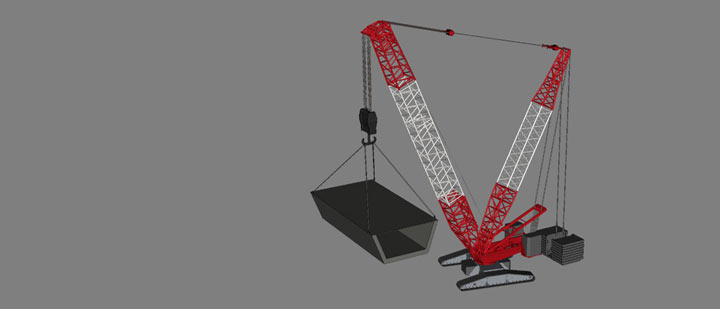Lattice boom mobile cranes are set up with long and elastic booms. They are mainly used for moving heavy payloads with a large hoisting radius. The maximum hoisting capacity of these cranes is about 3000 metric tonnes. Although loader cranes have a much lower maximum hoisting capacity of about 40 metric tonnes their stress calculation can be done using similar approaches. The stress calculation of lattice boom mobile cranes and loader cranes follows the rules of the European standards DIN EN 13001, DIN EN 13000 and DIN EN 12999. Several previous research projects have shown that the approaches in the standards often describe the dynamic effects only approximately for the motions of slewing, luffing and hoisting of grounded loads. The estimation of the dynamic loads in the stress calculation of cranes is consequently often based on the experience of the crane manufacturers. In order to do a more exact and reliable calculation, the standards allow the use of other methods to calculate dynamic effects. One possibility to calculate the dynamic behaviour of cranes is the use of the nonlinear dynamic finite element calculation. The main disadvantage of this method is the much higher computing time needed compared to the static approaches prescribed in the standards. Furthermore, there is no reasonable way to take partial safety factors into consideration. For these two reasons the dynamic calculation is used very rarely by crane manufacturers.
The objective of the research project is to develpop vibration models that allow exact calculations of the cranes' dynamic behaviour without a disappropriate increase in computing time. The models allow the calculation of static loads which describe the maximum dynamic load of cranes in a more exact way than loads based on the European standards. In addition It is also possible to use the partial safety factors in the stress calculation that are stipulated in the standard. The models enable an effective analysis of the dynamic behaviour of lattice boom mobile cranes and loader cranes and their usage could lead to improvements in crane safety in future.
As a former research project has shown that the results of the approaches in the standard are inaccurate for the processes of slewing and hoisting, vibration models are developed for these two working processes. The results of the vibration model are compared with the outcome of the nonlinear dynamic finite element calculation. The applicability of the models is tested for mobile cranes and loader cranes with various set-ups, different loads and different boom positions. To do further reviews of the exactness of the model, crane manufacturers compare the results using the vibration model and their currently used approaches.
